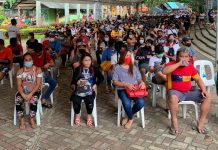A powerful earthquake that rattled Mindanao last week has triggered at least 120 aftershocks as of Thursday, the Philippine Institute of Volcanology and Seismology (Phivolcs) said.
Only 6 of the aftershock were felt, with the strongest recorded at magnitude 4.9, Phivolcs director Teresito Bacolcol said.
“It would probably take several days to several weeks bago siya mag-dissipate. Pero habang tumatagal naman, kumakaunti yung number and humihina po yung magnitude [ng aftershocks],” he said.
Last Friday’s quake killed at least nine people dead and left 17 others injured, the national disaster agency said.
People fled into the streets or hid under tables when the quake struck the Mindanao region, causing buildings to shake and part of a ceiling inside a shopping mall to collapse.
Some 1,700 houses were damaged or destroyed, the National Disaster Risk Reduction and Management Council said in its Wednesday update.
The state seismology service said the quake was likely generated by the movement of the earth’s crust along the Cotabato trench, a long, narrow depression on the seafloor that forms the boundary of one tectonic plate pushing against another.
Quakes are frequent in the Philippines, which sits along the Pacific “Ring of Fire”, an arc of intense seismic as well as volcanic activity that stretches from Japan through Southeast Asia and across the Pacific basin.
Most are too weak to be felt by humans.






